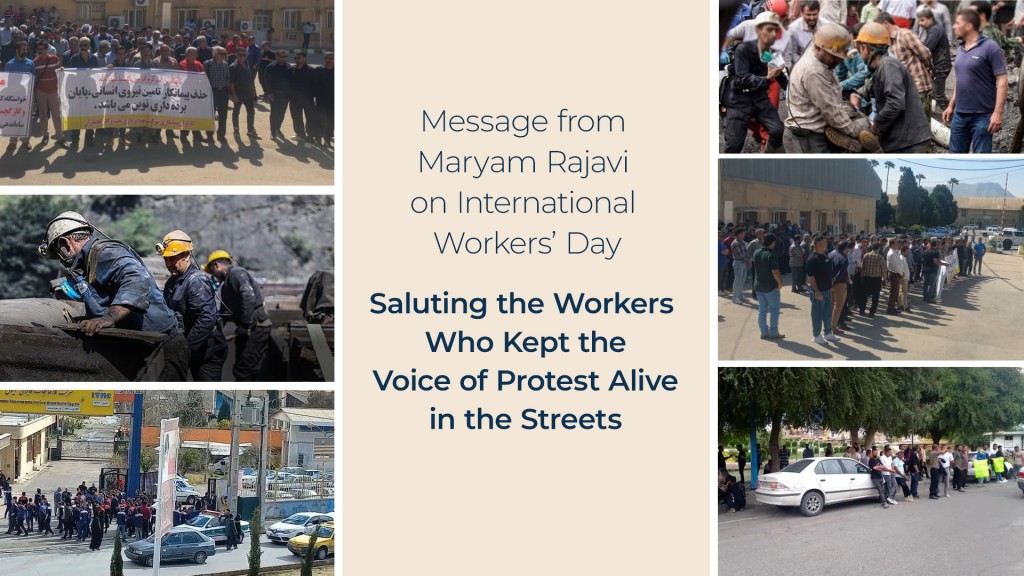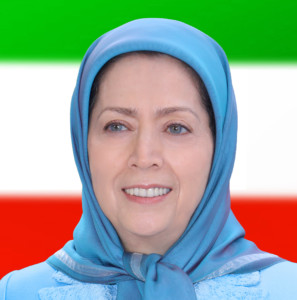Maryam Rajavi’s Message for International Workers’ Day 2025

Saluting the Workers Who Kept the Voice of Protest Alive in the Streets
To the Brave Workers and Toilers,
On this International Workers’ Day, I extend my heartfelt congratulations to you. This day is a blessed celebration for all who strive for a world free from tyranny and exploitation—a day that marks the end of suffering, poverty, homelessness, and injustice.
Salutations to the workers who have joined the Resistance Units over the past year. Salutations to the courageous workers who rose up and ensured that the voice of protest—the cry of “no” to oppression and exploitation, and the call for justice and a better world—did not fall silent in the streets.
On this day, we also stand in solidarity with the grieving families and those affected by the devastating explosion in Bandar Abbas, caused by the regime’s inhumane policy of stockpiling military and chemical weapons. The majority of the victims were workers.
We remember the 52 miners who perished in the tragic explosion at the Tabas coal mine last September, as well as the more than 2,000 workers who tragically lost their lives in workplace accidents this past year.
We honor the memory of the dozens of kolbars who were gunned down by Khamenei’s Revolutionary Guards, as well as the many imprisoned workers and impoverished laborers who were executed over the past year.
Across Iran, there is no workshop, prison, or street untouched by the blood or suffering of workers.
The clerical regime has survived only by this ruthless bloodshed and draining the strength and lifeblood of the working class. But ultimately, it will be reduced to ashes in the fire of their uprising.
Workers’ protests and strikes in Iran
Throughout the past year, workers have continued their protests and strikes across various production sectors. Retirees from the steel, telecommunications, and social security sectors, along with contract workers, municipal and industrial laborers, and mine workers, have risen again and again in protest.
Project workers in the oil, gas, and petrochemical industries, as well as workers in major industrial units such as the Wagon Pars Company, have played a critical role in sustaining the protest movement this year.
These protests are the sparks of a broader uprising—a movement against the brutal ruler of Iran, who has mobilized the regime’s entire apparatus to suppress Iran’s working class.
Khamenei is the foremost exploiter and plunderer in Iran—indeed, the country’s largest employer, wealthiest capitalist, and the principal enemy of the Iranian working class. Each year, he amasses vast personal wealth from Iran’s oil and petrochemical industries, as well as from monopolies in the production and distribution of medicine. Yet beyond these sources, his greatest income comes from the exploitation of Iran’s workers and laborers.
That’s why, in his speeches, he cynically urges workers to “work well,” to “value work,” to “treat it as a trust,” to “work diligently,” to “avoid cutting corners,” and to “maintain discipline in the workplace.”
The condition of workers under the clerical regime
Under the deceptive banners of “production” and “production leap,” Khamenei has seized control of Iran’s industry, agriculture, markets, imports, and exports through his multibillion-dollar foundations. While hypocritically repeating the slogan of “job security,” he has pursued a policy of temporary contracts and cheap labor that now affects over 90 percent of Iran’s workforce.
Such is the story of the monster lurking beneath Tehran’s Pasteur Square—the kingpin of the regime’s looters and thieves.
Over the past year, Masoud Pezeshkian—Khamenei’s obedient president—and his associates have been actively engaged in impoverishing the entire society. During his pre-election theatrics, he declared, “Inflation means emptying people’s pockets.” Now, he outpaces even his accomplices in doing just that.
From the very beginning, he built his administration on the regime’s Seventh Development Plan—the most anti-worker program the regime has introduced to date. Since the beginning of last year, workers’ purchasing power has been halved.
Widespread electricity and gas shortages have led to decreased production and the shutdown of manufacturing lines, resulting in a wave of worker layoffs.
According to regime officials, between 20 and 45 percent of Iran’s population now lives in informal settlements. Nearly all of them are workers and impoverished laborers.
Pension payments are regularly delayed—sometimes by weeks, sometimes by months. This year, the regime passed a new retirement law that increases the mandatory years of service. In doing so, they aim to cover the bankruptcy of pension funds at the expense of those who have labored for decades, draining what remains of their health and strength.
This injustice and exploitation are even more severe when it comes to working women. Eighty-five percent of women seeking employment remain jobless. Those who do find jobs suffer, first and foremost, from extreme job insecurity and instability. Secondly, their wages are 40 to 70 percent lower than the already meager salaries of male workers. Moreover, 28.5 million women in Iran are considered part of the inactive population, and the number of female heads of households has now reached five million.
The core issue is this: tens of millions of working-class families live under a regime that is their sworn enemy. As a result, survival itself has become a daily battle—taking on multiple jobs just to stay alive; living in slums instead of proper housing; accepting rock-bottom wages; watching innocent children forced into hard labor; and enduring dangerous, unsanitary working conditions—all in the name of survival.
This is the reality faced by industrial and manufacturing workers, service workers, project-based laborers, farmers, nurses, motorcycle couriers, street vendors, rice field workers, carpet-weaving girls, and the millions of underprivileged compatriots employed in start-ups.
The immense power of the Iranian worker
And yet, despite this mountain of injustice and oppression, Iran’s working class—comprising 20 million embattled laborers—possesses immense strength. With an organized uprising, it has the power to dismantle the foundations of plunder and injustice and bring down the theocratic regime as part of Iran’s great Liberation Army. The major uprisings since December 2017, which repeatedly shook the ground beneath Khamenei’s feet in hundreds of cities, were driven primarily by workers, the impoverished, and the deprived segments of society.
Today, you are far more prepared, vigilant, and battle-hardened to overthrow the Velayat-e Faqih regime. You clearly recognize the enemies of the people and the revolution—from the treacherous so-called reformists to the mercenaries of the regime’s intelligence services and remnants of the former dictatorship, who now, under the guise of forming a “strike fund,” attempt to extort money from international institutions for their personal gain.
The ruling oppressors have banned the formation of any labor unions, they reject strikes, and they label the establishment of councils and the takeover of production units as actions that threaten national security. They consider the fight for permanent contracts, access to proper housing, fair wages, and the dismantling of the contracting system as crimes.
These stolen rights, these denied rights, these criminalized rights can only be reclaimed through active participation in the ranks of the resistance to overthrow the regime.
This is where the value and greatness of the struggle of those thousands of brave and aware workers becomes evident—workers who have joined the ranks of the Resistance and the Resistance Units.
As workers have repeatedly shouted in their protests, their rights will only be won in the streets—only through revolt and struggle.
I call upon all compatriots to support the workers’ rightful protests.

